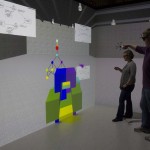Iowa State University & University of Illinois at Urbana-Champaign
Overview
This research seeks to explore new design processes, based on immersive technology, that support design team interaction in ways that achieve designs that could not be achieved with traditional interfaces. We want immersive computer design systems to embed design processes that are better than what humans can do on their own, and that arrive at better results, not just the same result, only faster. The key to achieving this vision is to use the unique capabilities of ICDT to support an increased level of technical understanding between cross disciplinary team members. In particular, we want to use ICDT technology to avoid many of the limitations and weaknesses of traditional design, while better exploiting the strengths that humans bring to the process. Humans employ a broad set of heuristics in order to function in the real world, particularly when dealing with large amounts of information and tradeoffs under uncertainty.
Most of these heuristics are necessary and useful shortcuts, and represent the unique contribution of human capabilities to the design process. However, some heuristics are systematically biased in ways that lead decision makers AWAY from the decision that is in their own best interests, resulting in designs that do not satisfy the designer’s true preference. For example, assigning weighting factors to reflect “relative importance” has been demonstrated to lead the designer to overcompensate, and create a design weakness that did not previously exist.
We do not desire to replace the “human in the loop” but to augment the skills and discussions among collaborators in ways that build upon the strengths of the human and the ICDT. We see the potential for ICDT to steer the design team away from getting trapped in a cycle of unintended consequences.
Posters
- Berg, Leif, Behdad, Sara, Vance, Judy M., and Thurston, Deborah (2012). Enhanced Immersive Technology to Improve Collaborative Decision Making (21 MB.) Emerging Technologies Conference, Ames, IA, April 19-20, 2012
- Berg, Leif, Behdad, Sara, Vance, Judy M., and Thurston, Deborah (2013). Enhanced Immersive Technology to Improve Collaborative Decision Making (17 MB.) Emerging Technologies Conference, Ames, IA, April 24-25, 2013
Publications
- Behdad, S., Berg, L., Thurston, D., and Vance, J., “Synergy between Normative and Descriptive Design Theory and Methodology” Accepted to the ASME 2012 International Design Engineering Technical Conferences & Computers and Information in Engineering Conference, IDETC/DTM 2013 Aug. 4-7, Chicago, Illinois, USA.
- Berg, L., Behdad, S., Vance, J., and Thurston, D., “Disassembly Evaluation and Training using Graph Visualization and Immersive Computing Technologies” Accepted to the ASME 2012 International Design Engineering Technical Conferences & Computers and Information in Engineering Conference, IDETC/CIE 2012 Aug. 12-15, Chicago, Illinois, USA.
- Behdad, S., Berg, L., Thurston, D., and Vance, J., “Integrating Immersive Computing Technology with Mixed-Integer Nonlinear Programming for Disassembly Sequence Planning under Uncertainty” Accepted to the ASME 2012 International Design Engineering Technical Conferences & Computers and Information in Engineering Conference, IDETC/DTM 2012 Aug. 12-15, Chicago, Illinois, USA.
- Behdad, S., Berg, L., Vance, J., and Thurston, D., “Immersive Computing Technology to Investigate Tradeoffs under Uncertainty in Disassembly Sequence Planning” Accepted to the ASME: Journal of Mechanical Design January 2012.
- Behdad, S., Berg, L., Thurston, D., and Vance, J., “Integrating Immersive Computing Technology with Mixed-Integer Nonlinear Programming for Disassembly Sequence Planning under Uncertainty” Accepted to the ASME: Journal of Mechanical Design May 2012.
Funding
- National Science Foundation – Grant Number: CMMI-1068926
